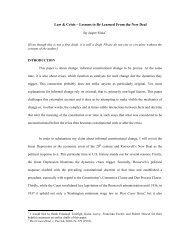updating brignoni-ponce - New York University School of Law
updating brignoni-ponce - New York University School of Law
updating brignoni-ponce - New York University School of Law
You also want an ePaper? Increase the reach of your titles
YUMPU automatically turns print PDFs into web optimized ePapers that Google loves.
572 LEGISLATION AND PUBLIC POLICY [Vol. 11:567<br />
The Court’s opinion in Terry neglected to mention that both codefendants<br />
were black and that the <strong>of</strong>ficer was white. 22 It created a<br />
fictional world in which police <strong>of</strong>ficers form suspicions about individuals<br />
without considering that person’s race. 23 Nearly thirty years<br />
later, the Court created a similar fiction in Whren v. United States. 24<br />
The issue in Whren was whether the <strong>of</strong>ficer’s consideration <strong>of</strong> race<br />
tainted a traffic violation stop based on probable cause. 25 The Court<br />
held that even if the <strong>of</strong>ficer’s decision was influenced by race, the stop<br />
did not violate the Fourth Amendment as long as the <strong>of</strong>ficers had<br />
probable cause to believe the driver violated the law. 26 In short, the<br />
Court refused to inquire about the <strong>of</strong>ficer’s subjective motivation for<br />
making the stop; 27 it preferred instead to present the “<strong>of</strong>ficer’s actions<br />
as resting upon neutral facts untainted by racial bias.” 28 As long as<br />
<strong>of</strong>ficers had probable cause to believe the driver had committed some<br />
traffic violation, they could decide to stop someone for “driving while<br />
Black” or “driving while Brown.” 29 While Terry and Whren ignore<br />
the use <strong>of</strong> race in police <strong>of</strong>ficers’ decisions, Brignoni-Ponce, discussed<br />
below, explicitly allows it to be a factor that creates reasonable<br />
suspicion in the context <strong>of</strong> immigration law enforcement.<br />
B. Brignoni-Ponce: Reasonable Suspicion and Permissibility <strong>of</strong><br />
Race as One <strong>of</strong> Many Factors<br />
Decided in 1975, Brignoni-Ponce continues to be cited for the<br />
proposition that it is permissible to use race in immigration enforcement.<br />
30 The case concerned a roving traffic stop by Border Patrol<br />
22. Anthony C. Thompson, Stopping the Usual Suspects: Race and the Fourth<br />
Amendment, 74 N.Y.U. L. REV. 956, 957, 964 (1999); see Terry, 392 U.S. at 5.<br />
23. Thompson, supra note 22, at 971. R<br />
24. Whren v. United States, 517 U.S. 806 (1996).<br />
25. See id. at 810.<br />
26. Id. at 813.<br />
27. Id. (“Subjective intentions play no role in ordinary, probable-cause Fourth<br />
Amendment analysis.”).<br />
28. Thompson, supra note 22, at 981–82. R<br />
29. Kevin R. Johnson, The Case for African American and Latina/o Cooperation in<br />
Challenging Racial Pr<strong>of</strong>iling in <strong>Law</strong> Enforcement, 55 Fla. L. Rev. 341, 343–44<br />
(2003) [hereinafter Johnson, Challenging Racial Pr<strong>of</strong>iling].<br />
30. See United States v. Montero-Camargo, 208 F.3d 1122, 1132 (9th Cir. 2000);<br />
United States v. Franco-Munoz, 952 F.2d 1055, 1058 n.2 (9th Cir. 1991) (Norris, J.,<br />
dissenting); United States v. Amaya-Ramos, No. CR-07-024-N-BLW, 2007 U.S. Dist.<br />
LEXIS 32465, at *6 (D. Idaho May 2, 2007); U.S. DEP’T OF JUSTICE, CIVIL RIGHTS<br />
DIV., GUIDANCE REGARDING THE USE OF RACE BY FEDERAL LAW ENFORCEMENT<br />
AGENCIES 9 (2003), available at http://www.usdoj.gov/crt/split/documents/guidance_on_race.pdf<br />
[hereinafter DOJ RACE GUIDANCE]. However, the Ninth Circuit<br />
has questioned its application in certain racial contexts. See infra Part II.C. Brignoni-<br />
Ponce could be read as either supporting the express use <strong>of</strong> race, in opposition to the
















